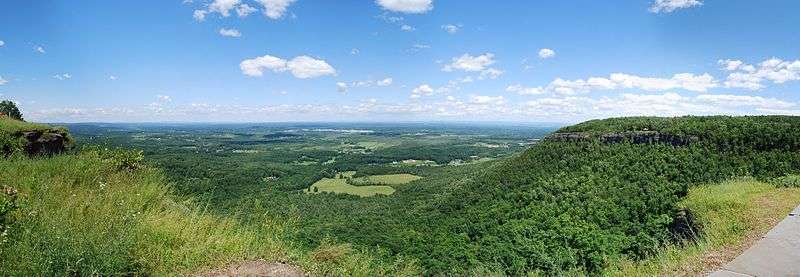Helderberg Escarpment
The Helderberg Escarpment is an escarpment in eastern New York, roughly 11 miles (18 km) west of the city of Albany.[1][2] The escarpment rises steeply from the Hudson Valley below, with an elevation difference of approximately 700 feet (from 400 to 1,100 feet) over a horizontal distance of approximately 2,000 feet. Much of the escarpment is within John Boyd Thacher State Park, and offers spectacular views of the Hudson Valley and the Albany area.
Geology

The escarpment is geologically related to three other escarpments, the Niagara escarpment, the Black River Escarpment, and the Onondaga Escarpment.[3] The rocks exposed in the escarpment date back to the Middle Ordovician to Early Devonian.
In 1934 the Schenectady Gazette described how the Tory cave, one of the limestone caves to be found in the escarpment, routinely had stalagmites of ice in the springtime.[4]
Transmission towers
A number of transmission towers have been installed to take advantage of the high ground above the escarpment.[5] In 2003 a 499-foot (152 m) tower was built on the highest point of the escarpment, for transmitting digital television signals.[6]
History
Dutch settlers first homesteaded the plateau above the escarpment in the 17th century.[7][8] Helderberg is a Dutch name meaning "clear mountain".[9]
The Open Space Institute and the Albany Land Conservancy are working to keep escarpment lands from being developed for housing or industrial uses.[10] Farmers farming land near the escarpment can apply to sell their development rights, to help make sure that land is not developed. In 2003 the Ten Eyck family, owners of the Indian Ladder Farm just below the escarpment, sold the development rights to their farm for $848,000. Two real estate assessment were done, one on the value of the property as a working farm, the other on its value as a potential site for urban development. The Ten Eycks were paid the difference in return for agreeing to keep the property as a working farm. They were the first property owners to sell their development rights in Albany County.


References
| Wikimedia Commons has media related to Helderberg Escarpment. |
- ↑ "Significant Habitats and Habit Complexes of the New York Bight Watershed: Helderberg Escarpment". United States Fish and Wildlife Service. Retrieved 2010-12-01.
- ↑ "Helderberg Escarpment List of Species of Special Emphasis". United States Fish and Wildlife Service. Retrieved 2010-12-01.
- ↑ "North Estonian Klint and some of its analogues". 2008. Archived from the original on 2013-08-01.
Helderberg Escarpment in Albany County, New York State, is up to 300 m high and traceable over more than 100 km. The escarpment exposes rock complexes from a nearly 70-million-year time period (Middle Ordovician to Early Devonian), representing a moderate-grade slope in which harder Coeymans (Devonian) and Onondaga (Silurian) limestones are distinguishable as escarpments a few dozen metres in height.
- ↑ "Icy Stalagmites in Tory Cave". Schenectady Gazette. 1934-03-30. Retrieved 2013-08-01 – via Google News Archive.
- ↑ FCC Registered Broadcast Land Mobile Towers in New Scotland, NY, http://www.city-data.com/towers/lmobile-New-Scotland-New-York.html
- ↑ Philip Schwartz (2005-02-20). "Area stations share a Helderberg tower". Daily Gazette (Schenectady). Retrieved 2013-08-01.
In late 2003, a single, 499-foot transmission tower went up on the Helderberg escarpment in the Town of New Scotland, just outside Albany at the highest point in the immediate area.
- ↑ John K. Elberfeld, Jane B. McLean (2012). Helderberg Hilltowns. Arcadia Publishing. ISBN 9780738592688.
- ↑ O. D. von Engeln (1988). "The Finger Lakes Region: Its Origin and Nature". Cornell University Press. ISBN 9780801495014. Retrieved 2013-08-01.
- ↑ Gannett, Henry (1905). The Origin of Certain Place Names in the United States. Govt. Print. Off. p. 154.
- ↑ Jill Bryce (2003-05-16). "New Scotland Orchard protected from development". Daily Gazette (Schenectady). pp. 1, 4. Retrieved 2013-08-01 – via Google News Archive.